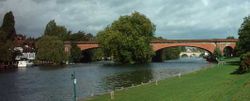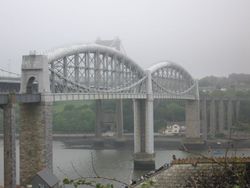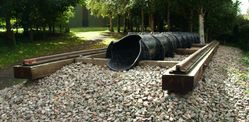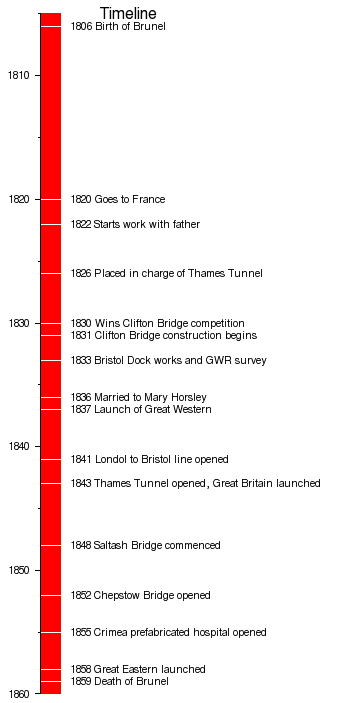Isambard Kingdom Brunel
2007 Schools Wikipedia Selection. Related subjects: Engineers and inventors
Isambard Kingdom Brunel, FRS ( 9 April 1806 – 15 September 1859) ( IPA: [ˈɪzəmbɑ(ɹ)d ˈkɪŋdəm brʊˈnɛl]), was an English engineer. He is best known for the creation of the Great Western Railway, a series of famous steamships, and numerous important bridges.
Though Brunel's projects were not always successful, they often contained innovative solutions to long-standing engineering problems. During his short career, Brunel achieved many engineering "firsts", including assisting in the building of the first tunnel under a navigable river and development of the first propeller-driven ocean-going iron ship, which was at the time also the largest ship ever built.
Brunel suffered several years of ill health, with kidney problems, before succumbing to a stroke at the age of 53. Brunel was said to smoke up to 40 cigars a day, and get by on only four hours of sleep a night.
In 2006, a major programme of events celebrated his life and work on the bicentenary of his birth under the name Brunel 200.
Early life
The son of engineer Sir Marc Isambard Brunel and Sophia, née Kingdom, Brunel was born in Portsmouth, Hampshire, on 9 April 1806. His father was working there on block-making machinery for the Portsmouth Block Mills.
At 14 he was sent to France to be educated at the Lycée Henri-Quatre in Paris and the University of Caen in Normandy. Brunel rose to prominence when, aged 20, he was appointed chief assistant engineer of his father's greatest achievement, the Thames Tunnel, which runs beneath the river between Rotherhithe and Wapping.
The first major sub-river tunnel, it succeeded where other attempts had failed, thanks to Marc Brunel's ingenious tunnelling shield — the human-powered forerunner of today's mighty tunnelling machines — which protected workers from cave-in by placing them within a protective casing. Marc Brunel had been inspired to create the shield after observing the habits and anatomy of the shipworm, Teredo navalis.
Most modern tunnels are cut in this way, notably the Channel Tunnel between England and France.
Brunel established his design offices at 17–18 Duke Street, London, and he lived with his family in the rooms above.
R.P. Brereton, who became his chief assistant in 1845, was in charge of the office in Brunel's absence, and also took direct responsibility for major projects such as the Royal Albert Bridge as Brunel's health declined.
The Thames Tunnel

Brunel worked for nearly two years to create a tunnel under London's River Thames, with tunnellers driving a horizontal shaft from one side of the river to the other under the most difficult and dangerous conditions.
Brunel's father, Marc, was the chief engineer, and the project was funded by the Thames Tunnel Company. The composition of the Thames river bed at Rotherhithe was often little more than waterlogged sediment and loose gravel, and although the extreme conditions proved the ingenuity of Brunel's tunnelling machine, the work was hard and hazardous.
The tunnel was often in imminent danger of collapse due to the instability of the river bed, yet the management decided to allow spectators to be lowered down to observe the diggings at a shilling a time.
For the workers the building of the tunnel was particularly unpleasant because the Thames at that time was still little better than an open sewer, so the tunnel was usually awash with foul-smelling, contaminated water.
Two severe incidents of flooding halted work for long periods, killing several workers and badly injuring the younger Brunel. The latter incident, in 1828, killed the two most senior miners, Collins and Ball, and Brunel himself narrowly escaped death; a water break-in hurled him from a tunnelling platform, knocking him unconscious, and he was washed up to the other end of the tunnel by the surge.
As the water rose, by luck he was carried up a service stairway, where he was plucked from almost certain death by an assistant moments before the surge receded. Brunel was seriously hurt (and never fully recovered from his injuries), and the event ended work on the tunnel for several years.
Nonetheless, the first underwater tunnel had been built, and is still in operation on the London Underground East London Line between Rotherhithe and Wapping.
The building that contained the pumps to keep the Thames Tunnel dry was saved from demolition in the 1970s by volunteers and made a Scheduled Ancient Monument. It now houses the Brunel Museum, which documents not just the Thames Tunnel but also the two Brunels' other achievements.
Bridges
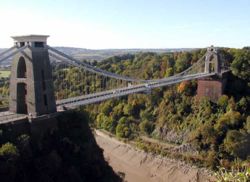
Brunel's solo engineering feats started with bridges — the Royal Albert Bridge spanning the River Tamar at Saltash near Plymouth, and an unusual timber-framed bridge near Bridgwater.
Built in 1838, the Maidenhead Railway Bridge over the Thames in Berkshire remains the flattest, widest brick arch bridge in the world and is still carrying main line trains to the west. There are two arches, with each span totalling 128 ft (39 m), having a rise of only 24 ft (7 m), and a width that carries four tracks.
The Royal Albert Bridge was designed in 1855 for the Cornwall Railway Company, after Parliament rejected his original plan for a train ferry across the Hamoaze — the estuary of the tidal Tamar, Tavy and Lynher. The bridge consists of two main spans of 455 ft (139 m), 100 ft (30 m) above mean high spring tide, plus 17 much shorter approach spans. Opened by Prince Albert on 2 May 1859, it was completed in the year of Brunel's death.
However, Brunel is perhaps best remembered for the Clifton Suspension Bridge in Bristol. Spanning over 700 ft (213 m), and nominally 200 ft (61 m) above the River Avon, it had the longest span of any bridge in the world at the time of conception. Brunel submitted four designs to a committee headed by Thomas Telford and gained approval to commence with the project. Afterwards, Brunel wrote to his brother-in-law, the politician Benjamin Hawes: "Of all the wonderful feats I have performed, since I have been in this part of the world, I think yesterday I performed the most wonderful. I produced unanimity among 15 men who were all quarrelling about that most ticklish subject — taste." He did not live to see it built, although his colleagues and admirers at the Institution of Civil Engineers felt the bridge would be a fitting memorial, and started to raise new funds and to amend the design. Work started in 1862 and was complete in 1864, five years after Brunel's death.
In 2006, there is the possibility that several of Brunel's bridges over the Great Western Railway might be demolished because the line is planned to be electrified, and there is inadequate clearance for the overhead wires. Buckinghamshire County Council is petitioning to have further options pursued, in order that all nine of the historic remaining bridges on the line can remain.
The Great Western Railway

In 1833, before the Thames Tunnel was complete, Brunel was appointed chief engineer of the Great Western Railway, one of the wonders of Victorian Britain, running from London to Bristol and later Exeter.
The Company was founded at a public meeting in Bristol in 1833, and was incorporated by Act of Parliament in 1835. Brunel made two controversial decisions: to use a broad gauge of 7 ft 0¼ in (2140 mm) for the track, which he believed would offer superior running at high speeds; and to take a route that passed north of the Marlborough Downs, an area with no significant towns, though it did offer potential connections to Oxford and Gloucester and then to follow the Thames Valley into London.
His decision to use broad gauge for the line was controversial in that almost all British railways to date had used standard gauge. Brunel said that this was nothing more than a carry-over from the mine railways that George Stephenson had worked on prior to making the world's first passenger railway.
Brunel worked out through mathematics and a series of trials that his broader gauge was the optimum railway size for providing stability and a comfortable ride to passengers, in addition to allowing for bigger carriages and more freight capacity. He surveyed the entire length of the route between London and Bristol himself.
The initial group of locomotives ordered by Brunel to his own specifications proved unsatisfactory, apart from the North Star locomotive, and 20-year-old Daniel Gooch (later Sir Daniel) was appointed as Superintendent of Locomotives. Brunel and Gooch chose to locate their locomotive works at the village of Swindon, at the point where the gradual ascent from London turned into the steeper descent to the Avon valley at Bath.
Drawing on his experience with the Thames Tunnel, the Great Western contained a series of impressive achievements — soaring viaducts, specially designed stations, and vast tunnels including the famous Box Tunnel, which was the longest railway tunnel in the world at that time.
Brunel's achievements ignited the imagination of the technically minded Britons of the age, and he soon became one of the most famous men in the country on the back of this interest.
There is an anecdote which states that Box Tunnel is placed such that the sun shines all the way through it on Brunel's birthday. For more information, see Box Tunnel.
After Brunel's death the decision was taken that standard gauge should be used for all railways in the country. Despite the Great Western's claim of proof that its broad gauge was the better (disputed by at least one Brunel historian), the decision was made to go with Stephenson's standard gauge, mainly because this had already covered a far greater amount of the country.
By May 1892 (when the broad gauge was abolished) the Great Western had already been re-laid as dual gauge (both broad and standard) and so the transition was a relatively painless one.
The great achievement that was the Great Western Railway has been immortalised in the Swindon Steam Railway Museum.
Brunel's "atmospheric caper"
Another of Brunel's interesting though ultimately unsuccessful technical innovations was the atmospheric railway, the extension of the GWR southward from Exeter towards Plymouth, technically the South Devon Railway (SDR), though supported by the GWR. Instead of using locomotives, the trains were moved by Clegg and Samuda's patented system of atmospheric ( vacuum) traction, whereby stationary pumps sucked air from the tunnel.
The section from Exeter to Newton (now Newton Abbot) was completed on this principle, with pumping stations with distinctive square chimneys spaced every two miles, and trains ran at approximately 20 miles per hour (30 km/h). Fifteen-inch (381 mm) pipes were used on the level portions, and 22-inch (559 mm) pipes were intended for the steeper gradients.
The technology required the use of leather flaps to seal the vacuum pipes. The leather had to be kept supple by the use of tallow, and tallow is attractive to rats. The result was inevitable — the flaps were eaten, and vacuum operation lasted less than a year, from 1847 (experimental services began in September; operationally from February 1848) to September 10, 1848.
The accounts of the SDR for 1848 suggest that atmospheric traction cost 3s 1d (three shillings and one penny) per mile compared to 1s 4d/mile for conventional steam power. A number of South Devon Railway engine houses still stand, including that at Starcross, on the estuary of the River Exe, which is a striking landmark, and a reminder of the atmospheric railway, also commemorated as the name of the village pub.
A section of the pipe, without the leather covers, is preserved at the Didcot Railway Centre.
Transatlantic shipping
Even before the Great Western Railway was opened, Brunel was moving on to his next project: transatlantic shipping. He used his prestige to convince his railway company employers to build the Great Western, at the time by far the largest steamship in the world. She first sailed in 1837.
She was 236 ft (72 m) long, built of wood, and powered by sail and paddlewheels. Her first return trip to New York City took just 29 days, compared to two months for an average sailing ship. In total, 74 crossings to New York were made. The Great Britain followed in 1843; much larger at 322 ft (98 m) long, she was the first iron-hulled, propeller-driven ship to cross the Atlantic Ocean.
Building on these successes, Brunel turned to a third ship in 1852, even larger than both of her predecessors, and intended for voyages to India and Australia. The Great Eastern (originally dubbed Leviathan) was cutting-edge technology for her time: almost 700 ft (213 m) long, fitted out with the most luxurious appointments and capable of carrying over 4,000 passengers.
She was designed to be able to cruise under her own power non-stop from London to Sydney and back since engineers of the time were under the misapprehension that Australia had no coal reserves, and she remained the largest ship built until the turn of the century. Like many of Brunel's ambitious projects, the ship soon ran over budget and behind schedule in the face of a series of momentous technical problems.
The ship has been portrayed as a white elephant, but it can be argued that in this case Brunel's failure was principally one of economics — his ships were simply years ahead of their time. His vision and engineering innovations made the building of large-scale, screw-driven, all-metal steamships a practical reality, but the prevailing economic and industrial conditions meant that it would be several decades before transoceanic steamship travel emerged as a viable industry.
Great Eastern was built at John Scott Russell's Napier Yard in London, and after two trial trips in 1859, set forth the following year on her maiden voyage from Southampton to New York on 17 June 1860 with Mr. and Mrs. Daniel Gooch, Norman Scott Russell (Scott Russell's son), Alexander Lyman Holley and Zerah Colburn among the passengers. John Scott Russell, who had intended to sail on the maiden voyage, remained at home. Holley travelled as one of Scott Russell's personal friends. Norman Scott Russell stayed with Holley in New York for a few weeks.
Though a failure at its original purpose of passenger travel, she eventually found a role as an oceanic telegraph cable-layer, and the Great Eastern remains one of the most important vessels in the history of shipbuilding — the Trans-Atlantic cable had been laid, which meant that Europe and America now had a telecommunications link.
Illnesses and death of Brunel
In 1843, while performing a conjuring trick for the amusement of his children, Brunel accidentally inhaled a half-sovereign coin, which became lodged in his windpipe. A special pair of forceps failed to remove it, as did a machine devised by Brunel himself to shake it loose.
Eventually, at the suggestion of Sir Marc, Brunel was strapped to a board and turned upside-down, and the coin was jerked free. He convalesced by visiting Teignmouth and enjoyed the area so much that he purchased an estate at Watcombe.
Brunel suffered a stroke in 1859, just before the Great Eastern made her first voyage to New York. He died ten days later at the age of 53 and was buried, like his father, in Kensal Green Cemetery in London.
He left behind his wife Mary and three children: Henry Marc Brunel (1842–1903), Isambard Brunel Junior (1837–1902), and Florence Mary Brunel (c.1847–1876). Henri Marc enjoyed some success as a civil engineer.
Brunel had also designed Brunel Manor and its gardens in Torquay, Devon to be his retirement home. Unfortunately he never saw the house or gardens finished, as he died before it was completed.
Legacy
Many monuments to Brunel exist. There are statues in London at Temple (pictured), Bristol, Saltash, Milford Haven, Nyeland and Paddington station. The flagpole of the Great Eastern is at the entrance to Liverpool FC, and a section of the ship's funnel is at Sutton Poyntz, near Weymouth.
Contemporary locations bear Brunel's name, such as Brunel University in London, and a collection of streets in Exeter: Isambard Terrace, Kingdom Mews, and Brunel Close. A road and school in his home town of Portsmouth are also named in his honour, along with the town's largest pub. Although not of any real architectural merit, the Brunel shopping centre in Bletchley, Milton Keynes is named after him.
Most of Brunel's bridges are still in use. The Thames Tunnel is now part of the London Underground, and the Brunel Engine House at Rotherhithe that once housed the steam engines that powered the tunnel pumps still stands, as a museum dedicated to the work and lives of Marc and Isambard Kingdom Brunel.
Many of Brunel's original papers and designs are now held in the Brunel collection at the University of Bristol.
In 1972, Harry Harrison's alternate history novel Tunnel Through the Deeps features a character similar to Brunel, Sir Isambard Brassey-Brunel.
In 1975, noted British animator Bob Godfrey was awarded an Oscar for his short film, Great, an irreverent musical look at Brunel and his times.
An opera about him was given a concert performance at the Colston Hall, Bristol on 18 July 1993, the day before the 150th anniversary of the launch of the SS Great Britain. Titled Isambard Kingdom Brunel, and written by Will Todd and Ben Dunwell, The Times noted that it was an "epic tale of passion, wild ambition and insanity". In 1994 Todd wrote the orchestral suite Brunel.
Brunel was placed second of the heavily publicised " 100 Greatest Britons" TV poll conducted by the BBC and voted for by the public. In the second round of voting, which concluded on 24 November 2002, Brunel was placed second, behind Winston Churchill. The building of the Great Eastern was dramatised in an episode of the BBC TV series Seven Wonders of the Industrial World (2003).
The image of Brunel used to illustrate the cover of a children's book, The Life of Isambard Kingdom Brunel published by Heinemann in March 2005, was altered because of fears that the image of Brunel smoking a cigar would provide an unsuitable role model for five to seven year olds and might result in school libraries not buying the book.
Brunel is mentioned in the song "Rain, Steam & Speed" by The Men They Couldn't Hang.
Brunel's name is used for one of the "Great Engineers" in the game Civilization IV.
In the post-apocalyptic science fiction Greatwinter novels by Sean McMullen, Brunel is revered as a prophet by a guild of Australian engineers who manage the wind- and pedal-powered "paraline" train system.
In 2006, the Royal Mint struck a £2 coins to "celebrate the 200th anniversary of Isambard Kingdom Brunel and his achievements". The coin depicts a section of the Royal Albert Bridge at Saltash, along with a portrait of Brunel. The Post Office issued a set of commemorative stamps.
On 8 April 2006, Bristol celebrated Brunel's 200th birthday with a series of festivities. These included a concert of brass bands, an epic saxophone ensemble, a choral piece and a fireworks display over the Avon Gorge culminating in the switching on of new lighting for the Clifton Suspension Bridge.
|
|
Trivia
- Brunel could draw a perfect circle.
- Winston Churchill beat Brunel in the BBC's "Greatest Briton" poll by fewer than 57 thousand votes.
- The Screw propeller he designed and built was found to be only five percent less efficient than a computer-designed model.
Television
- National Geographic Channel - The Iron Engineers

